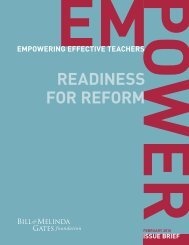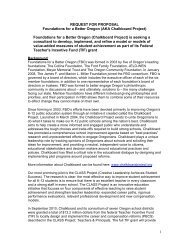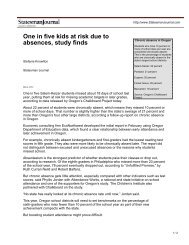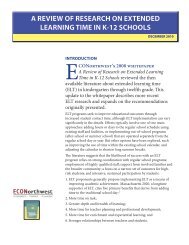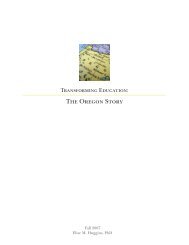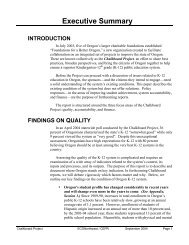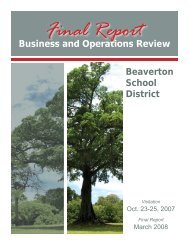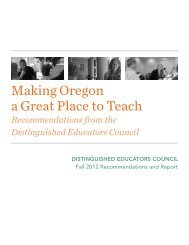Tapping the Potential - Alliance for Excellent Education
Tapping the Potential - Alliance for Excellent Education
Tapping the Potential - Alliance for Excellent Education
Create successful ePaper yourself
Turn your PDF publications into a flip-book with our unique Google optimized e-Paper software.
TA P P I N G T H E P O T E N T I A L : R E TA I N I N G A N D D E V E L O P I N G H I G H - Q U A L I T Y N E W T E A C H E R S• Standards-based evaluation. Some new teachers may not be ideally suited <strong>for</strong> teaching.Standards-based evaluation of all beginning teachers provides a mechanism <strong>for</strong> determiningwhe<strong>the</strong>r or not new teachers should move <strong>for</strong>ward in <strong>the</strong> profession.To retain teachers and improve <strong>the</strong>ir overall quality, comprehensive induction shouldbe accompanied by <strong>the</strong> following essential elements that create high-functioning learningcommunities within schools:• strong principal leadership;• high-quality providers of <strong>the</strong> induction program with dedicated staff resources;• additional support <strong>for</strong> new teachers with little preparation;• incentives <strong>for</strong> teachers to participate in induction activities;• alignment between induction, classroom needs, and professional standards; and• an adequate and stable source of funding.States, districts, and local schools all view and practice induction in different ways.There<strong>for</strong>e, it is important to distinguish what is and is not meant in this report by <strong>the</strong>term “induction.”What Comprehensive Induction Is Not• Induction is not a crash course in teaching. Teachers must be prepared with contentknowledge and teaching skills when <strong>the</strong>y enter <strong>the</strong> classroom. But just as inductionis not a substitute <strong>for</strong> quality preparation, nei<strong>the</strong>r is preparation a substitute <strong>for</strong>quality induction.• Induction is not an orientation session in which administrators tell teachers where <strong>the</strong>copy machine and refrigerator are located. Induction incorporates teachers into <strong>the</strong>teaching profession.• Induction is not a stand-alone mentoring program, however rigorous it may be. Inductiondoes include time <strong>for</strong> new teachers to work with mentors to improve <strong>the</strong>ir instruction.But induction also must include additional components to effectively retainand develop teachers. 27• Induction is not a string of disconnected one-day workshops. To be effective, inductionmust be embedded in <strong>the</strong> professional culture of every school and district with <strong>the</strong>strong support of school leaders. 28• Induction is not a top-down, unidirectional approach to teacher learning where new teachersare expected to be only passive recipients. Beginners also have knowledge andskills to offer existing teachers, mentors, administrators, and principals, and <strong>the</strong>exchange of in<strong>for</strong>mation benefits everyone.• Induction is not just of benefit to beginning teachers. High-quality veteran teachers alsocan improve <strong>the</strong>ir skills by participating in induction through common planningtime with inductees and by serving as mentors and instructional leaders. 29• Induction is not a way to help teachers cope with dysfunctional schools that leaves <strong>the</strong>root causes of poor working conditions untouched. Induction can facilitate positive,systemic change in <strong>the</strong> local school environment and, ultimately, in <strong>the</strong>teaching profession.3



